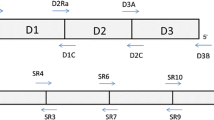Abstract
The armoured dinoflagellate Peridinium is widely distributed in freshwater environments worldwide and contains a large number of species. Their identity, however, has remained elusive, since the small cells tend to be morphologically similar. To help resolve this, a sequence-based diagnostics for uncultured Peridinium cells from field samples was applied, using single-cell PCR and direct DNA sequencing of the PCR products. Single cells were isolated randomly from field samples, and PCR successfully amplified the target rDNA regions from the crude lysates. Phylogenetic trees showed that all the cells were strongly grouped into the same clade (> 99% bootstrap value), including the previously identified P. bipes f. occultatum, and apparently separated from relatives such as P. cinctum, P. volzii and P. willei. All 17 isolates were genotypically identified as P. bipes f. occultatum, based on over than 99% of sequence similarities, and the organism was responsible for water blooms at different seasons in Korean waters. The sequence-based typing could clearly resolve P. bipes f. occultatum from the various Peridinium cells, and that the method is accurate and more labor-saving than the conventional method to monitor Peridinium species. This protocol may be useful for the application of molecular tools to uncultured Peridinium cells.
Similar content being viewed by others
References
Adachi M, Sako Y, Ishida Y (1994) Restriction fragment length polymorphism of ribosomal DNA internal transcribed spacer and 5.8S regions in Japanese Alexandrium species (Dinophyceae). J. Phycol. 30: 857–863.
Bolch CJS (2001) PCR protocols for genetic identification of dinoflagellates directly from single cysts and plankton. Phycologia 40: 162–167.
Charrel RN, de Micco P, de Lamballerie X (1999) Convenient method to improve the graphical quality of phylogenetic trees computed by the MEGA program. Biotechniques 27: 702–704.
Chesnick JM, Kooistra WHCF, Wellbrock U, Medlin L (1997) Ribosomal RNA analysis indicates a benthic pennate diatom ancestry for the endosymbionts of the dinoflagellates Peridinium foliaceum and Peridinium balticum (Pyrrophyta). J. Eukaryot. Microbiol. 44: 314–320.
Daugbjerg N, Hansen G, Larsen J, MoestrupØ (2000) Phylogeny of some of the major genera of dinoflagellate based on ultrastructure and partial LSU rDNA sequence data, including the erection of three new genera of unarmoured dinoflagellates. Phycologia 39: 302–317.
Edvardsen B, Shalchian-Tabrizi K, Jakobsen KS, Medlin LK, Dahl E, Brubak S, Paasche E (2003) Genetic variability and molecular phylogeny of Dinophysis species (Dinophyceae) from Norwegian waters inferred from single cell analyses of rDNA. J. Phycol. 39: 395–408.
Elster H-J, Ohle W (1968) Die Binnengewässer: Einzeldarstellungen aus der Limnologie und ihren Nachbargebieten.E. E. Schweizerbart’s Verlagsbuchhandlung, Stuttgart, Germany.
Godhe A, Otta SK, Rehnstam-Holm AS, Karunasagar I, Karunasagar I (2001) Polymerase chain reaction (PCR) based detection of Gymnodinium mikimotoi and Alexandrium minutum in field samples from Southwest India. Mar. Biotechnol. 3: 152–162.
Hansen G, Daugbjerg N, Henriksen P (2000) Comparative study of Gymnodinium mikimotoi and Gyrodinium aureolum, Comb. Nov. (Gyrodinium aureolum), based on morphology, pigment composition, and molecular data. J. Phycol. 36: 394–410.
Inagaki Y, Dacks JB, Doolittle WF, Watanabe KI, Ohama T (2000) Evolutionary relationship between dinoflagellates bearing obligate diatom endosymbionts: Insight into tertiary endosymbiosis. Int. J. Syst. Evol. Microbiol. 50: 2075–2081.
Kawabata Z, Hirano Y (1995) Growth pattern and cellular nitrogen and phosphorus contents of the dinoflagellate Peridinium penardii (Lemm.) Lemm. causing a freshwater red tide in a reservoir. Hydrobiologia 312: 115–120.
Ki J-S (1998). Ecological studies on Togyo Reservoir in Chulwon, Korea: Seasonal succession of phytoplankton community structures with an emphasis on the genus Peridinium (Dinophyceae) (in Korean), M.Sc. Thesis, Hanyang University, Seoul.
Ki J-S, Cho SY, Han M-S (2005) Morphological characteristics of Peridinium bipes f. occcultatum (Dinophyceae) isolated from three geographically segregated aquatic systems of Korea. Korean J. Limnol. In press.
Ki J-S, Jang GY, Han M-S (2004) Integrated method for single-cell DNA extraction, PCR amplification, and sequencing of the ribosomal DNA from harmful dinoflagellates Cochlodinium polykrikoides and Alexandrium catenella. Mar. Biotechnol. In press.
Marín I, Aguilera A, Reguera B, Abad JP (2001) Preparation of DNA suitable for PCR amplification from fresh or fixed single dinoflagellate cells. Biotechniques 30: 88–93.
Penna A, Magnani M (2000) A PCR immunoassay method for the detection of Alexandrium (Dinophyceae) species. J. Phycol. 36: 1183–1186.
Ruiz Sebastián C, O’ryan C (2001) Single-cell sequencing of dinoflagellate (Dinophyceae) nuclear ribosomal genes. Mol. Ecol. Note 1: 329–331.
Saldarriaga JF, Taylor FJR, Keeling PJ, Cavalier-Smith T (2001) Dinoflagellate nuclear SSU rRNA phylogeny suggests multiple plastid losses and replacements. J. Mol. Evol. 53: 204–213.
Sambrook J, Fritsch EF, Maniatis T (1989) Molecular Cloning: A Laboratory Manual, Cold Spring Harbor Press, New York, NY.
Saunders GW, Hill DR, Sexton JP, Andersen RA (1997) Small-subunit ribosomal RNA sequences from selected dinoflagellates: Testing classical evolutionary hypotheses with molecular systematic methods. In Bhattacharya D (ed), Origins of Algae and their Plastids, Springer-Verlag, Wein, New York, NY, pp. 237–259.
Scholin CA, Herzog M, Sogin ML, Anderson DM (1994) Identification of group and strain-specific genetic markers for globally distributed Alexandrium (Dinophyceae). Part II. Sequence analysis of a fragment of the LSU rDNA gene. J. Phycol. 30: 999–1011.
Thompson JD, Higgins DG, Gibson TJ (1994) CLUSTAL W: Improving the sensitivity of progressive a multiple sequence alignment through sequence weighting, positions-specific gap penalties and weight matrix choice. Nucleic Acids Res. 22: 4673–4680.
Author information
Authors and Affiliations
Rights and permissions
About this article
Cite this article
Ki, JS., Han, MS. Sequence-based diagnostics and phylogenetic approach of uncultured freshwater dinoflagellate Peridinium (Dinophyceae) species, based on single-cell sequencing of rDNA. J Appl Phycol 17, 147–153 (2005). https://doi.org/10.1007/s10811-005-7211-y
Received:
Revised:
Accepted:
Issue Date:
DOI: https://doi.org/10.1007/s10811-005-7211-y




